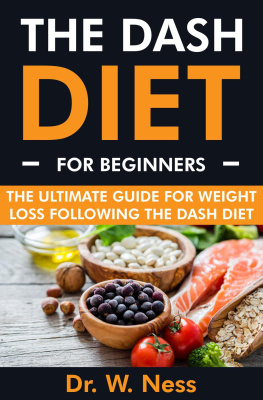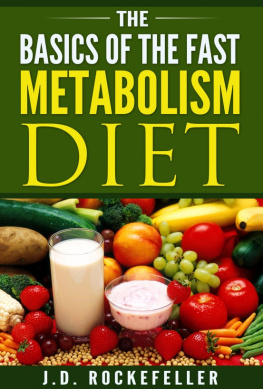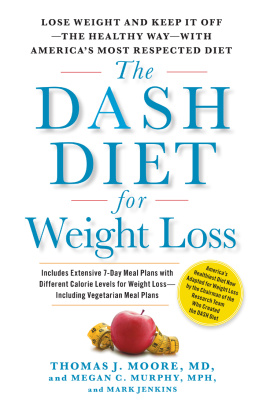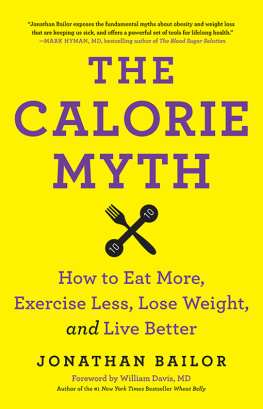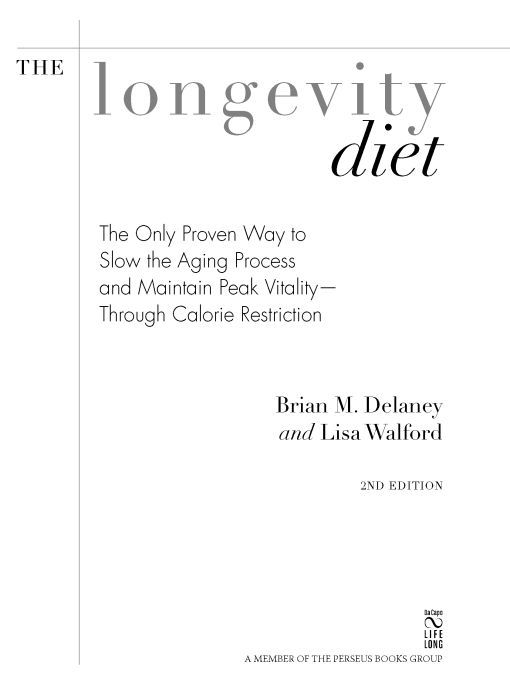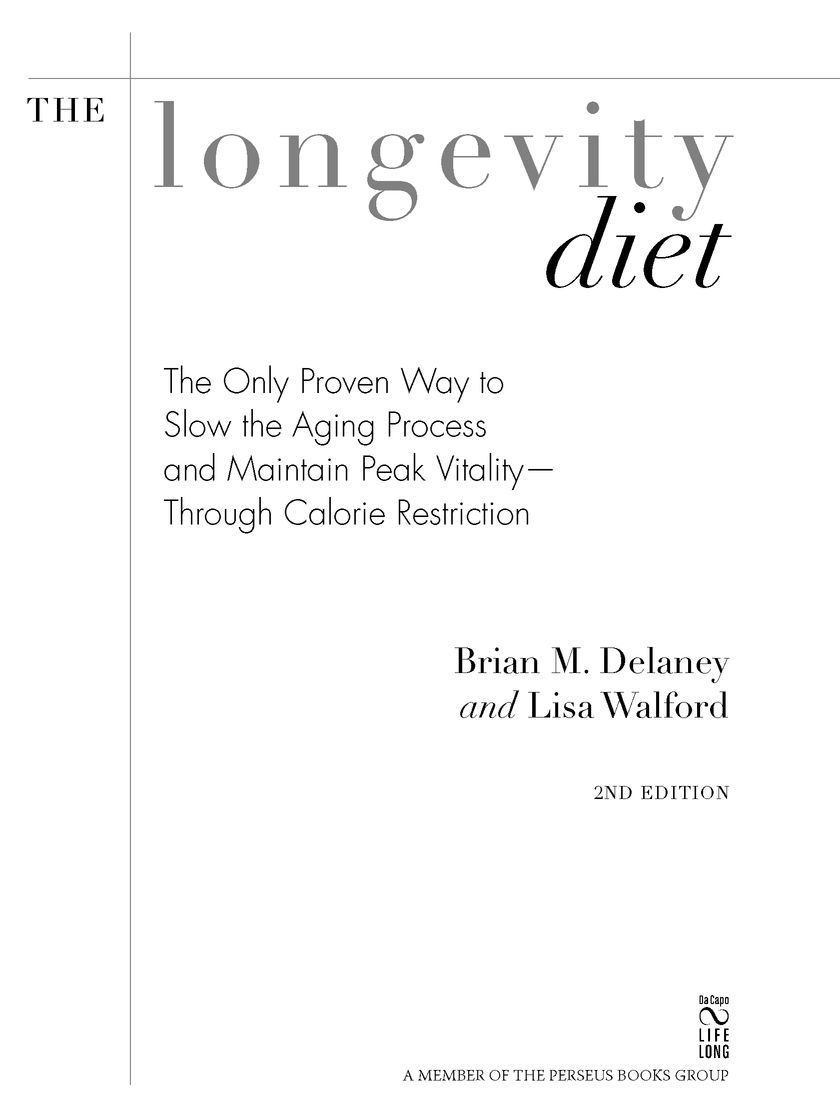Table of Contents
WHAT THE WALL STREET JOURNAL AND THE NEW YORK TIMES ARE REPORTING ABOUT CALORIE RESTRICTION:
New research shows that calorie-restriction diets, which cut calories by as much as 40 percent of your normal intake, may help you live a longer life.
The Wall Street Journal
A low-calorie diet, even in people who are not obese, can lead to changes in metabolism and body chemistry that have been linked to better health and longer life, researchers are reporting.... There is a Calorie Restriction Society with members all over the world, and its president, Brian M. Delaney, estimates that the people experimenting on themselves number in the thousands.
The New York Times
PRAISE FOR THE LONGEVITY DIET:
This book is a valuable tool for those interested in living a longer, healthier life. My research with laboratory animals has shown that a nutrient-rich, calorically reduced diet slows the aging process, decreases age-associated mortality, and increases longevity. Delaney and Walford translate the results of my and others research into practical terms that are easy to understand and easy to put into practice. This is not a rigid diet book. It is a flexible program that guides the reader towards a healthier way of eating and living. Follow the advice in this book and you will very likely see many extra years of health and vigor.
Stephen R. Spindler, PhD, Professor of Biochemistry, University of California, Riverside
The Longevity Diet offers a new way of living. It helps readers mull over a commitment to themselves to live long and healthy and how to achieve it. You can take baby steps at first if you arent ready to change every eating habit, and charts help you choose nutrient-dense foods that are still filling and satisfying. The book addresses the deleterious effects of stress that often induce humans to overeat. Forget the idea of eating to lose weight, or even to feel better. Trade calories for years of healthy living. Thats the Longevity Diet.
Bill Sardi, Knowledge of Health, Inc., author of The Anti-Aging Pill and How to Live 100 Years without Growing Old
THIS BOOK IS DEDICATED TO THE MEMORY OF
Professor Roy L. Walford,
whose work followed the Enlightenment motto: dare to know! and whose life followed his own motto: dare to live!
FOREWORD
By Dr. Roy Walford
I have spent most of my professional life researching the relationship between level of caloric intake and longevity.
Year after year I would witness the dramatic results of calorie restriction in my laboratory at the University of California-Los Angeles. The animals eating a normal diet would start turning gray, their hair would start falling out, their bones would get brittle, they would start moving more and more slowly, and then they would stop moving forever. While these changes were taking place in the one group, there was a group of mice next to them going through something entirely different. This other group was on the CR (calorie restriction) diet. These animals retained an astonishing youth and vitality. At an age when most of the mice eating the normal diet were deada human equivalent of eighty-five or ninety yearsnearly all of the mice on the CR diet were alive and, indeed, thriving! The females were even able to conceive! The aging process was slowed so dramatically that many of the mice on the CR diet lived to be a human equivalent of over 140 years, some even beyond 150 years!
I was well aware of Clive McCays seminal research on dietary restriction, in the 1930s at Cornell University. His rodents were put on their regime early in life, one in which they were severely and abruptly restricted. Much has transpired since Dr. Richard Weindruch and I postulated and proved in my laboratory that adult-onset CR in mice, if done gradually, would trigger the health benefits described above.
At that time, I started writing books explaining the scientific principles behind CR, making the case that CR, even when started in adulthood, will almost certainly have the same effects in people as those seen in laboratory animals. We are compelled to say almost because the studies needed to prove this would of course take more than a century to conclude. But, as so far tested, CR works across nearly the whole animal kingdom, so it would indeed be surprising if it did not work in humans. Moreover, studies on monkeys currently underway in three laboratories in the United States very clearly show that the extensive physiological and biochemical changes seen in CR rodents are also found in CR monkeys, to whom we are extremely closely related. In addition, the human studies I personally participated in, monitored, and published results upon, while the medical officer inside the experimental habitat Biosphere 2, also show the same changes.
More studies are under way, and preliminary results all point in the same direction: the CR effect appears to be universal in the animal kingdom. Researchers at Washington University, for example, have just published a report in the journal Nature showing that people on CR manifest the same changes in cholesterol, fasting glucose, insulin levels, and other parameters of health as those seen in nonhuman animals on CR. The question is: How can people best put this diet into practice?
My daughter, Lisa Walford, and Brian M. Delaney have written this book with just that practical question in mind. Lisa has extensive experience with CR. She codesigned a software program that helps the user track nutrients in the diet and coauthored a book on CR with me several years ago, titled The Anti-Aging Plan. Brian was the founder of the first Internet-based life-extension group, Sci.life-extension, and is the president of the CR Society, a nonprofit group whose purpose is to support people practicing CR and participating in CR research.
The Longevity Diet is a multipurpose book. If you want to aim for six or seven score vital years, this book will explain how. If you have a less radical goal and simply want to reduce your chances of being felled by the heart attacks or cancer that struck many of your ancestors, this book will explain how.
And even if your principal motivation is vanityand theres nothing wrong with that!this book will provide what is probably the best way to look better and keep looking better. People who go on a diet in the normal sense, i.e., people who are simply trying to lose weight because they want to look good, have a recidivism rate of around 95 percent. That means that, after one year, 95 percent of the people who have gone on a weight-loss diet are back at the weight they started with. On the Longevity Diet, success rates are much, much higher. This may simply have to do with the difference in motivation. A desire to be healthy may have more staying power than a desire to be thin. But it probably has more to do with the diet itself. Instead of strange, unnatural-seeming levels of fats and proteins that we find in fad diets, the Longevity Diet, especially in its milder forms, is a diet focused simply on fruits and vegetables and other nutrient-rich foods that make sense to eat. In addition, the selection of more healthful foods leads naturally to mild to moderate weight loss, which produces health benefits that reinforce these new dietary choices.



